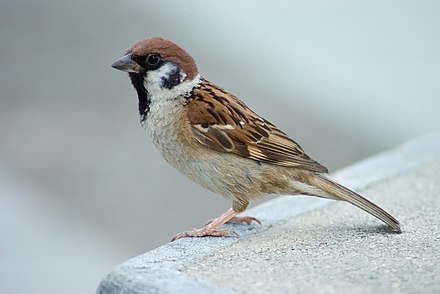Sparrow, usually refers to a group of small birds belonging to the order Passeriformidae, especially the house sparrow (Passer domesticus), which is a species widely distributed around the world. House sparrows are a species closely related to humans and are known for their ubiquity in human-inhabited areas.

Body shape: The body length of sparrows is generally between 14 and 18 centimeters, with a chubby body and a short and thick beak. The shape of the beak is suitable for its seed-based food.
Weight: Approximately 24 to 39.5 grams.
Appearance: They usually have tan and black feathers. Male house sparrows have a distinct black patch on their chests, while females have more subdued colors with browns and grays.
Food habits: Sparrows mainly eat grains and seeds, but they will also eat insects and other small animals, especially during the breeding season, to ensure that their chicks have enough protein to grow.
Habitat: House sparrows can survive almost anywhere humans live, from rural farmland to urban centers. They build nests in cities and take advantage of building gaps and other sheltered areas.
Behavior: They are well adapted to urban life, many sparrows are used to foraging on the ground and they will also visit bird feeders.
Breeding: Sparrows are social birds that usually breed in groups. Their breeding season varies by region, but is mostly in late spring and summer.
Nest: Sparrow nests are usually constructed from straw, feathers, paper, and other soft materials that can be found.
Egg laying: Usually 3 to 5 eggs are laid each time. The female will incubate for about two weeks, and the chicks can fly away from the nest about two weeks after hatching.
Sparrows play some important roles in ecosystems, including controlling insect populations and dispersing plant seeds. However, the populations of some sparrow species have declined over the past few decades, in part due to habitat loss and changes in urban environments. Some countries and regions have begun to implement conservation measures to protect sparrow populations.
Sparrows have long co-existed with humans, but they are sometimes considered pests because they eat seeds and newly sprouted crops in farmland. Nonetheless, the presence of sparrows also delights many city dwellers and becomes part of urban wildlife. In some cultures, sparrows are even considered a symbol of good luck.
Generally speaking, although sparrows are common small birds, they may face different threats in different areas. Protecting their habitat and living environment is crucial to maintaining sparrow populations.
animal tags: sparrow
We created this article in conjunction with AI technology, then made sure it was fact-checked and edited by a Animals Top editor.